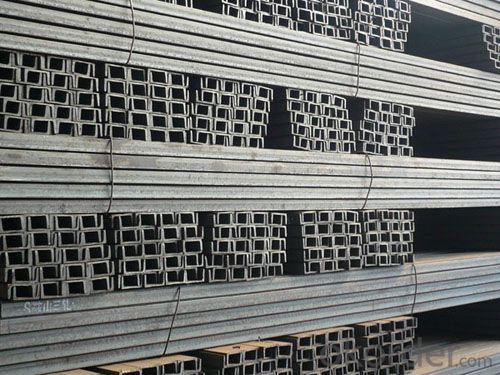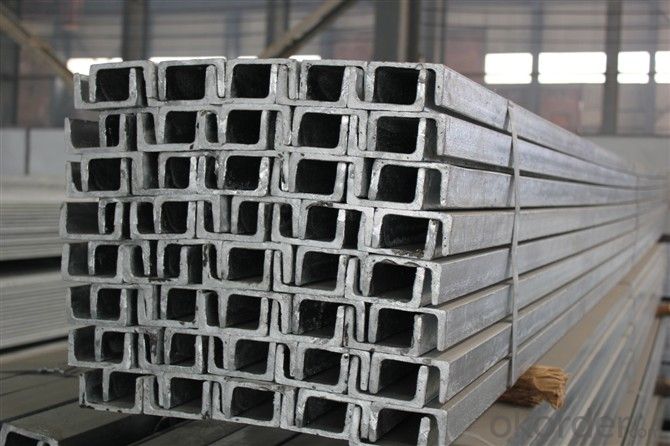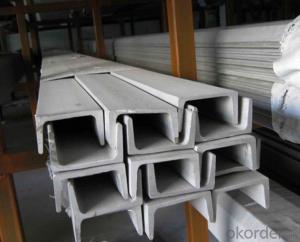GB U Channel 50MM-300MM High Quality Hot Rolled
- Loading Port:
- Tianjin
- Payment Terms:
- TT or LC
- Min Order Qty:
- 25 m.t.
- Supply Capability:
- 20000 m.t./month
OKorder Service Pledge
OKorder Financial Service
You Might Also Like
Product Description:
OKorder is offering high quality Hot Rolled Steel I-Beams at great prices with worldwide shipping. Our supplier is a world-class manufacturer of steel, with our products utilized the world over. OKorder annually supplies products to European, North American and Asian markets. We provide quotations within 24 hours of receiving an inquiry and guarantee competitive prices.
Product Applications:
According to the needs of different structures, Angle can compose to different force support component, and also can be the connections between components. It is widely used in various building structures and engineering structures such as roof beams, bridges, transmission towers, hoisting machinery and transport machinery, ships, industrial furnaces, reaction tower, container frame and warehouse etc
Product Advantages:
OKorder's Steel I-Beams are durable, strong, and resist corrosion.
Main Product Features:
· Premium quality
· Prompt delivery & seaworthy packing (30 days after receiving deposit)
· Corrosion resistance
· Can be recycled and reused
· Mill test certification
· Professional Service
· Competitive pricing
Product Specifications:
Manufacture: Hot rolled
Grade: Q195 – 235
Certificates: ISO, SGS, BV, CIQ
Length: 6m – 12m, as per customer request
Packaging: Export packing, nude packing, bundled
Sizes: 25mm-250mm | ||
a*t | ||
25*2.5-4.0 | 70*6.0-9.0 | 130*9.0-15 |
30*2.5-6.6 | 75*6.0-9.0 | 140*10-14 |
36*3.0-5.0 | 80*5.0-10 | 150*10-20 |
38*2.3-6.0 | 90*7.0-10 | 160*10-16 |
40*3.0-5.0 | 100*6.0-12 | 175*12-15 |
45*4.0-6.0 | 110*8.0-10 | 180*12-18 |
50*4.0-6.0 | 120*6.0-15 | 200*14-25 |
60*4.0-8.0 | 125*8.0-14 | 250*25 |
FAQ:
Q1: How do we guarantee the quality of our products?
A1: We have established an advanced quality management system which conducts strict quality tests at every step, from raw materials to the final product. At the same time, we provide extensive follow-up service assurances as required.
Q2: How soon can we receive the product after purchase?
A2: Within three days of placing an order, we will begin production. The specific shipping date is dependent upon international and government factors, but is typically 7 to 10 workdays.
Q3: What makes stainless steel stainless?
A3: Stainless steel must contain at least 10.5 % chromium. It is this element that reacts with the oxygen in the air to form a complex chrome-oxide surface layer that is invisible but strong enough to prevent further oxygen from "staining" (rusting) the surface. Higher levels of chromium and the addition of other alloying elements such as nickel and molybdenum enhance this surface layer and improve the corrosion resistance of the stainless material.



- Q:Can steel channels be used for curtain wall framing?
- Yes, steel channels can be used for curtain wall framing. They provide structural support and can withstand the required loads and pressures associated with curtain wall systems.
- Q:How do steel channels contribute to the stability of bridges?
- Playing a crucial role in bridge stability, steel channels, also known as structural channels or C-channels, have specific designs that enhance overall strength and provide structural support. To begin with, steel channels are utilized to support the bridge's deck or roadway. Typically installed horizontally, they serve as the primary load-bearing element, distributing weight evenly across the bridge from vehicles, pedestrians, and other loads. This effective transfer of loads prevents excessive stress or strain on individual components, ensuring the stability of the entire structure by transmitting the loads to the bridge's supporting piers or abutments. Furthermore, steel channels contribute to the lateral stability of bridges. When installed vertically, they act as bracing elements, resisting horizontal forces like wind or seismic activity that could cause the bridge to sway or deform. By effectively counteracting these forces, steel channels reduce the risk of structural failure and maintain stability even during adverse conditions. In addition to their load-bearing and bracing capabilities, steel channels offer flexibility in bridge design. Engineers can utilize their versatility to create different bridge configurations, such as truss or box girder bridges, to optimize strength and stability based on site-specific requirements. Moreover, steel channels are renowned for their durability and resistance to corrosion. This makes them an ideal choice for bridge construction, as they can withstand harsh environmental conditions like moisture, chemicals, and temperature fluctuations without compromising their structural integrity. By maintaining their strength over time, steel channels ensure the long-term stability and safety of the bridge. In summary, steel channels significantly contribute to bridge stability by providing load-bearing support, resisting lateral forces, allowing for flexible design options, and offering durability against corrosion. Their crucial role in bridge construction guarantees efficient and safe accommodation of various loads and environmental conditions, ensuring the safety and reliability of bridges for years to come.
- Q:Can steel channels be welded together?
- Certainly, it is feasible to weld steel channels together. Welding serves as a prevalent technique in order to unite steel channels, thus establishing a robust and long-lasting connection. The process entails heating the steel channels until they reach their melting point and subsequently utilizing a filler material to amalgamate them. Depending on the specific necessities and the nature of the steel channels being united, welding can be executed through diverse techniques such as arc welding, MIG welding, or TIG welding. Nevertheless, it is imperative to guarantee the adherence to proper welding procedures and techniques to attain a weld of exceptional quality that meets the desired standards of strength and integrity.
- Q:How do steel channels contribute to energy efficiency in buildings?
- Steel channels contribute to energy efficiency in buildings in several ways. Firstly, steel channels are often used as structural components in building frames. These frames provide stability and support to the structure, allowing for the construction of taller buildings with more open floor plans. By using steel channels instead of traditional building materials like wood or concrete, the weight of the building can be reduced, leading to less energy consumption during construction and transportation. Additionally, steel channels are known for their durability and strength. This strength allows for the creation of longer spans and larger openings, which in turn can optimize natural lighting and ventilation in a building. By maximizing the use of natural light, the need for artificial lighting is reduced, resulting in lower energy consumption and cost. Similarly, improved natural ventilation can reduce the reliance on air conditioning systems, resulting in energy savings. Furthermore, steel channels can be used in the construction of energy-efficient building envelopes. Building envelopes are designed to minimize heat transfer between the interior and exterior environment. Steel channels are often incorporated into the framing of walls, roofs, and floors, providing a strong and stable structure that can support insulation materials. This insulation helps to maintain a comfortable indoor temperature year-round, reducing the need for heating or cooling systems and ultimately saving energy. Lastly, steel channels are recyclable, which contributes to the sustainability of a building. At the end of a building's lifespan, steel channels can be easily salvaged and recycled into new steel products. This reduces the demand for virgin materials and minimizes the carbon footprint associated with manufacturing new building materials. Overall, steel channels play a significant role in improving energy efficiency in buildings by reducing construction weight, enabling natural lighting and ventilation, enhancing insulation capabilities, and promoting sustainability through recycling.
- Q:What is the maximum length of steel channels available?
- The maximum length of steel channels available can vary depending on the manufacturer and the specific type of steel channel. However, in general, steel channels are commonly available in standard lengths ranging from 20 feet (6.1 meters) to 40 feet (12.2 meters). Some manufacturers may offer customized lengths beyond these standard sizes, but it is important to note that longer lengths may require special handling and transportation arrangements.
- Q:Can steel channels be used for fencing?
- Yes, steel channels can be used for fencing. They provide strength, durability, and security, making them an ideal choice for fencing applications.
- Q:How do steel channels contribute to building durability?
- Steel channels contribute to building durability in several ways. Firstly, they provide structural support and reinforcement to the building, enhancing its overall strength and resistance to external forces such as wind, earthquakes, or heavy loads. Additionally, steel channels are highly durable themselves, as they are made from high-quality steel that is resistant to corrosion, decay, and pests. This ensures that the channels maintain their structural integrity over time, contributing to the long-term durability of the building. Lastly, steel channels also facilitate the installation and integration of various building systems, such as electrical, plumbing, or HVAC, further enhancing the overall efficiency and durability of the building.
- Q:What are the different types of steel channel connections for door frames?
- There are several different types of steel channel connections that are commonly used for door frames. These include: 1. Welded Connections: This is the most common type of connection used for steel channel door frames. In this method, the steel channels are welded together at the corners to form a strong and secure frame. 2. Bolted Connections: Another common type of connection is the use of bolts to connect the steel channels. Holes are drilled in the channels, and bolts are inserted and tightened to hold the frame together. This type of connection allows for easy disassembly and reassembly if needed. 3. Riveted Connections: Rivets can also be used to connect steel channel door frames. This method involves drilling holes in the channels and inserting rivets to hold them together. Riveted connections provide a strong and durable connection. 4. Corner Brackets: In some cases, corner brackets may be used to connect the steel channels. These brackets are typically made of steel and are attached to the corners of the channels using screws or bolts. Corner brackets provide additional stability and strength to the door frame. 5. Adjustable Connections: Some steel channel door frames may have adjustable connections. These connections allow for easy adjustment of the frame during installation to ensure it is level and plumb. Adjustable connections typically use screws or bolts to hold the channels in place and allow for flexibility in positioning. Overall, the choice of steel channel connection for a door frame will depend on factors such as the specific requirements of the project, the desired level of strength and stability, and the ease of installation and maintenance.
- Q:Is outside building protection single row bent with cantilever steel instead of channel steel?
- Construction of single door rack erection of cantilever I-beam steel can not be used instead of steel, because the provisions of article 6.10.2 JGJ130-2011 "construction of steel tubular scaffold safety technical specifications" cantilever beam application of biaxial symmetry,...... steel beams shall not be less than 160mm. Therefore, the channel shall not be used, the cross section is asymmetrical, and the cantilever bent, the cross section is more likely to be unstable.
- Q:Can steel channels be used for both residential and commercial construction?
- Yes, steel channels can be used for both residential and commercial construction. Steel channels are versatile structural components that can be used in various applications, including building frames, support beams, and in the construction of walls and ceilings. They provide strength and stability, making them suitable for both residential and commercial projects. Additionally, steel channels are durable, fire-resistant, and have a high load-bearing capacity, making them ideal for construction projects of different sizes and types.
1. Manufacturer Overview |
|
|---|---|
| Location | |
| Year Established | |
| Annual Output Value | |
| Main Markets | |
| Company Certifications | |
2. Manufacturer Certificates |
|
|---|---|
| a) Certification Name | |
| Range | |
| Reference | |
| Validity Period | |
3. Manufacturer Capability |
|
|---|---|
| a)Trade Capacity | |
| Nearest Port | |
| Export Percentage | |
| No.of Employees in Trade Department | |
| Language Spoken: | |
| b)Factory Information | |
| Factory Size: | |
| No. of Production Lines | |
| Contract Manufacturing | |
| Product Price Range | |
Send your message to us
GB U Channel 50MM-300MM High Quality Hot Rolled
- Loading Port:
- Tianjin
- Payment Terms:
- TT or LC
- Min Order Qty:
- 25 m.t.
- Supply Capability:
- 20000 m.t./month
OKorder Service Pledge
OKorder Financial Service
Similar products
New products
Hot products
Related keywords




























